Aquarium Conditioned
Multicolor Lubbock's Fairy Wrasse
Cirrhilabrus lubbocki, Indonesia
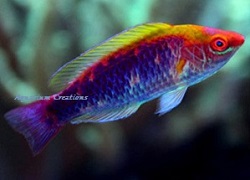 YouTube Video Multicolor Lubbock's Fairy Wrasse
YouTube Video Multicolor Lubbock's Fairy Wrasse
Description:
The Tricolor Fairy Wrasse is a great schooling fairy wrasse. Beautiful colors and easy feeding requirements make this fairy wrasse a good choice for both beginners and advanced aquarists alike. These are extremely colorful small, peaceful "pseudo-schooling" fish that could easily be used in many reef tanks instead of more aggressive anthias species. They can be found in large groups around reefs. They seem to have an affinity for finely branched corals and rubble. Max size is about 3" but they are more commonly seen in the 1.5" - 2" range. When kept in small groups or singly, they also make great nano tank additions. They are hardy and reef safe. The males tend to have more vivid and striking color patterns than the females.
Tank Recommendations:
The maximum adult size is around 3 inches. We recommend keeping in a tank of at least 75 gallons in size. A 2-3 inch sand bed so they can bury themselves in the sand to sleep or hide. Live Rock should be provided for all Fairy and Filament Wrasses. The Live Rock provides numerous small life forms that the Wrasses consider a tasty treat as well as another place to hide when they feel threatened. Note: Wrasses are known to jump from aquariums. Be sure to have some sort of covering with no large open holes that they can escape from.
Food and diet:Best to feed several smaller meals a day rather than one large meal. Best practice is to use a refugium as part of the system’s filtration. This will provide a constant food supply of small live foods (e.g. copepods). A regular diet should include vitamin enriched frozen mysis shrimp, vitamin enriched frozen brine shrimp, and other meaty foods along with a high quality marine flake and marine pellet food.
Reef Compatability: Excellent
Level of Care: Easy
Approximate Purchase Size:
2 inches to 3 inches
|
$53.99
|
Aquarium Conditioned
Naoko's Fairy Wrasse
Cirrhilabrus naokoae
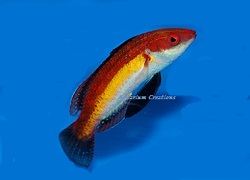
Youtube Video Naoko's Fairy Wrasse
Description:
The rare (and some would say ULTRA-RARE) Naoko's Fairy Wrasse is a reef-associated wrasse currently only known to be around Indonesia and Sumatra. First described by Jack Randall and Dr. Hiroyuki Tanaka in January 2009, this is a fairly peaceful wrasse that is both active and hardy. Cirrhilabrus naokoae is not an overly aggressive fish, and multiple may be kept in the same aquarium if it is a suitably large aquarium. With the Naoko's Fairy Wrasse, like most fairy wrasse, the male is the better looking of the pqir, with a bright red, yellow and white body, a black pectoral fin, and black, red and blue anal and dorsal fins. During the courting period the male will be displaying his brightly colored fins to attract its mate. Multiple Naoko's Fairy Wrasses may be kept together safely including multiple males. It is also perfectly suitable to keep Naoko's with other fairy wrasses, as long as the others are peaceful community fish. A peaceful fish, they should not bother other fish, coral or inverts in your tank. This makes the Naoko's Fairy Wrasse a great addition to reef tanks.
Tank Recommendations:
The maximum adult size is around 3 inches. We recommend keeping in a tank of at least 50 gallons in size. A 2-3 inch sand bed so they can bury themselves in the sand to sleep or hide. Live Rock should be provided for all Fairy and Filament Wrasses. The Live Rock provides numerous small life forms that the Wrasses consider a tasty treat as well as another place to hide when they feel threatened. Note: Wrasses are known to jump from aquariums. Be sure to have some sort of covering with no large open holes that they can escape from.
Food and diet:This fish is not a picky eater and should readily accept a variety of common foods including small pieces of marine flesh (e.g., table shrimp), frozen food, and flake and pellet foods. Best to feed several smaller meals a day rather than one large meal. Best practice is to use a refugium as part of the system’s filtration. This will provide a constant food supply of small live foods (e.g. copepods). A regular diet should include vitamin enriched frozen mysis shrimp, vitamin enriched frozen brine shrimp, and other meaty foods along with a high quality marine flake and marine pellet food.
Reef Compatability: Excellent
Level of Care: Easy
Approximate Purchase Size:
2 inches to 3 inches
|
$149.99
|
Aquarium Conditioned
Ruby Long Fin Fairy Wrasse
Cirrhilabrus rubeus, Indian Ocean
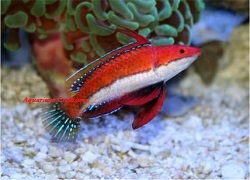 Youtube Video Ruby Long Fin Fairy Wrasse
Youtube Video Ruby Long Fin Fairy Wrasse
Description: It is commonly known as the Ruby Longfin Fairy Wrasse but is also known as the Blue and Red Fairy Wrasse and also as the Social Wrasse for its splendid behavior. Coloration of the Long Fin Fairy Wrasse does vary greatly so expect some variety in the color of the Long Fin. A marine fish from the genus Cirrhilabrus which is part of the Labridae family. Very beautiful and colorful, the Longfin Fairy has a mostly red with orange body, scarlet ventral and anal fins and a pale underbelly. The Male Longfin Fairy Wrasses will tend to be the more colorful of the pair. Ruiby Longfin Fairy Wrasses reach a maximum adult size of around 3 inches. A peaceful fish, they should not bother other fish, coral or inverts in your tank. This makes the Longfin Fairy Wrasse a great addition to reef tanks.
Tank Recommendations:
The maximum adult size is around 3 inches. We recommend keeping in a tank of at least 50 gallons in size. A 2-3 inch sand bed so they can bury themselves in the sand to sleep or hide. Live Rock should be provided for all Fairy and Filament Wrasses. The Live Rock provides numerous small life forms that the Wrasses consider a tasty treat as well as another place to hide when they feel threatened. Note: Wrasses are known to jump from aquariums. Be sure to have some sort of covering with no large open holes that they can escape from.
Food and diet:Best to feed several smaller meals a day rather than one large meal. Best practice is to use a refugium as part of the system’s filtration. This will provide a constant food supply of small live foods (e.g. copepods). A regular diet should include vitamin enriched frozen mysis shrimp, vitamin enriched frozen brine shrimp, and other meaty foods along with a high quality marine flake and marine pellet food.
Reef Compatability: Excellent
Level of Care: Easy
Approximate Purchase Size:
2 inches to 3 inches
|
$52.99
|
Aquarium Conditioned
Violet Flasher Fairy Wrasse
Paracheilinus sp., Australia
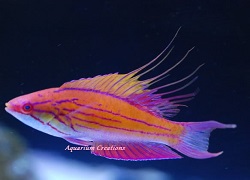
Description: A newcomer to the aquarium trade and first described just 10 years ago, The Violet Flasher Wrasse is a wonderful reef fish that can be the highlight of a peaceful community or reef tank. A member of the Labridae family, the Violet Flasher Wrasse hails from Australia and the Tongan Islands. They are one of the few wrasses who do well with small, passive marine fish, as they will encourage them to spend more time out of the rock work. Males are most spectacular when they "flash" (display) toward other fishes or their reflections in the aquarium glass. They can be kept in groups and, in fact, in some cases they do best if a male and a few females are kept together. One of the most rewarding things about keeping flasher wrasses in groups is that the males will display a lot more. These colourful displays are important in courtship and defending females from neighboring rivals.
Tank Recommendations:
The maximum adult size is around 3 inches. We recommend keeping in a tank of at least 50 gallons in size. A 2-3 inch sand bed so they can bury themselves in the sand to sleep or hide. Live Rock should be provided for all Fairy and Filament Wrasses. The Live Rock provides numerous small life forms that the Wrasses consider a tasty treat as well as another place to hide when they feel threatened. Note: Wrasses are known to jump from aquariums. Be sure to have some sort of covering with no large open holes that they can escape from.
Food and diet:Best to feed several smaller meals a day rather than one large meal. Best practice is to use a refugium as part of the system’s filtration. This will provide a constant food supply of small live foods (e.g. copepods). A regular diet should include vitamin enriched frozen mysis shrimp, vitamin enriched frozen brine shrimp, and other meaty foods along with a high quality marine flake and marine pellet food.
Reef Compatability: Excellent
Level of Care: Easy
Approximate Purchase Size:
2 inches to 3 inches
|
$99.99
|
Aquarium Conditioned
Yellow-Flanked Fairy Wrasse
Cirrhilabrus lyukyuensis
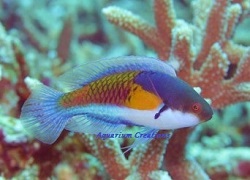 Youtube Video of Yellow-Flanked Fairy Wrasse
Youtube Video of Yellow-Flanked Fairy Wrasse
Description:
The Yellow-Flanked Fairy Wrasse is also known as Blueside Fairy Wrasse. The Yellow-Flanked Fairy Wrasse, Cirrhilabrus lyukyuensis, is also known as the Blueside Wrasse and the Blueheaded Fairy Wrasse. These fish come from the Eastern Indian Ocean. Females have a reddish-orange body with a white belly. Males have a greenish-blue front half and a reddish back half with a yellow patch behind the pectoral fins. This is a species that seems to improve in the intensity of its coloration as it matures in the aquarium. It is one of the more aggressive fairy wrasses, and this, combined with its relatively large size and active nature, means it is best kept in larger tanks at least 90 gallons. When in the process of courting it is fairly easy to tell the difference because the male will display increased color intensities. A popular aquarium fish because of the strong coloration, the picture of this beauty does not do it justice. Of large importance to note, the Yellow-Flanked Fairy Wrasse adapts better than many other fairy wrasses to captivity but still may need occassional live foods like brine shrimp or copepods till they gain a gusto for eating well.
Tank Recommendations:
The maximum adult size is around 5 inches. We recommend keeping in a tank of at least 90 gallons in size. A 2-3 inch sand bed so they can bury themselves in the sand to sleep or hide. Live Rock should be provided for all Fairy and Filament Wrasses. The Live Rock provides numerous small life forms that the Wrasses consider a tasty treat as well as another place to hide when they feel threatened. Note: Wrasses are known to jump from aquariums. Be sure to have some sort of covering with no large open holes that they can escape from.
Food and diet:
Best to feed several smaller meals a day rather than one large meal. Best practice is to use a refugium as part of the system’s filtration. This will provide a constant food supply of small live foods (e.g. copepods). A regular diet should include vitamin enriched frozen mysis shrimp, vitamin enriched frozen brine shrimp, and other meaty foods along with a high quality marine flake and marine pellet food.
Reef Compatability: Excellent
Level of Care: Easy
Approximate Purchase Size: 2-3/4 inches to 4 inches
|
$69.99
|
Aquarium Conditioned
Labout's Fairy Wrasse
Cirrhilabrus laboutie, Australia
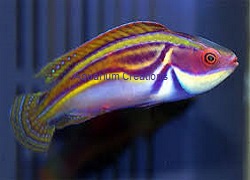 YouTube Video Labout's Fairy Wrasse
YouTube Video Labout's Fairy Wrasse
Description:
The Laboute's Fairy Wrasse, Cirrhilabrus laboutei is native to the coral reefs of the Barier Reef to the coral reefs of New Caledonia and as far east as Vanuatu. The Cirrhilabrus laboutei has long been a favorite of aquarists, boasting an unreal mix of colors and patterns that few fish can come close to. Mature males are colored purple dorsally, with a contrasting white belly. Along the sides are a series of stripes in teal, yellow and a much darker shade of purple. These form a sort of looped line above the pectoral fin. Both males and females have these stripes but the colors of the males are much more intense. Relatively easy to adapt in captivity the Labouti Fairy Wrasse will be shy upon introduction to your home aquarium but become more bold as time goes on and will then spend hours and hours moving about in the water column. If continually harassed they will hide and refuse to eat. If you will be keeping more than one Laboutei in your tank add all the females and other fairy wrasses first because doing it any other way the male Labouti Fairy Wrasse may behave aggressively to the new introductions.
Tank Recommendations:
The maximum adult size in the wild is around 6 inches, maxium aqurium size will be slightly smaller. We recommend keeping in a tank of at least 70 gallons in size, of course with aquariuum health the bigger the better is always the case. A 2-3 inch sand bed so they can bury themselves in the sand to sleep or hide. Live Rock should be provided for all Fairy and Filament Wrasses. The Live Rock provides numerous small life forms that the Wrasses consider a tasty treat as well as another place to hide when they feel threatened. Note: Wrasses are known to jump from aquariums. Be sure to have some sort of covering with no large open holes that they can escape from.
Food and diet:Best to feed several smaller meals a day rather than one large meal. Best practice is to use a refugium as part of the system’s filtration. This will provide a constant food supply of small live foods (e.g. copepods). Easily adjusts to captive diet. Feed a varied diet consisting of finely chopped chunks of meaty foods. These foods include krill, raw table shrimp, squid, clam and mussel. It is also a good idea to occasionally supplement with some type of herbivore diet. For frozen aquarium foods we suggest vitamin enriched frozen mysis shrimp, vitamin enriched frozen brine shrimp, and other meaty foods along with a high quality marine flake and marine pellet food.
Reef Compatability: Excellent
Level of care: Easy
Approximate Purchase Size:
Large 2-/2" to 3-1/2", XLarge 3-1/2 to 4-1/2
|
Medium $199.99
Large $239.99
XLarge $299.99
Male/Female Pair Australia $499.99
|
|

 YouTube Video Multicolor Lubbock's Fairy Wrasse
YouTube Video Multicolor Lubbock's Fairy Wrasse

 Youtube Video Ruby Long Fin Fairy Wrasse
Youtube Video Ruby Long Fin Fairy Wrasse

 Youtube Video of Yellow-Flanked Fairy Wrasse
Youtube Video of Yellow-Flanked Fairy Wrasse
 YouTube Video Labout's Fairy Wrasse
YouTube Video Labout's Fairy Wrasse